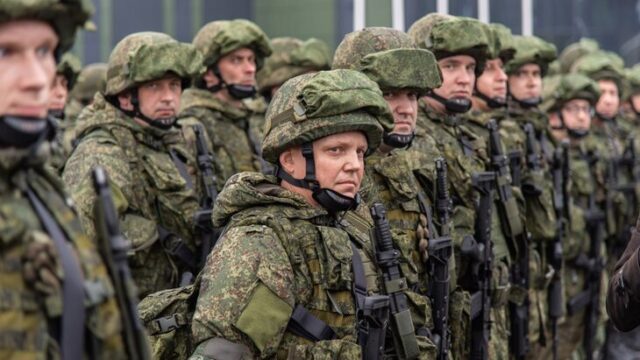
The Russian Military’s Inflation Paradox
Publication: Eurasia Daily Monitor Volume: 20 Issue: 187
By:

On November 27, President Vladimir Putin signed into law the Russian federal budget for 2024–26 and planning period for 2025–26. As part of the budget, national defense spending for 2024 will be close to 10.8 trillion rubles ($119.6 billion, according to the expected exchange rate) and national security spending will reach almost 3.4 trillion rubles ($37.6 billion). That means 14.2 trillion rubles ($157.2 billion) of the 36.7 trillion rubles ($407 billion) for total budget expenditures, or 38.7 percent, are being set aside for the Russian Armed Forces, intelligence services, and law enforcement agencies. Several days later, on December 1, Putin increased the numerical strength of the armed forces from 1,150,628 to 1,320,000 soldiers and officers (Minfin.gov.ru, November 1; Minfin.gov.ru, November 27; Kremlin.ru, December 1). These recent developments underscore the Kremlin’s need to produce somewhat empty demonstrations of confidence to offset growing domestic discontent and present a strong front in the run-up to the March 2024 presidential elections (Meduza, December 7).
These announcements suggest that Moscow is trying to scare Kyiv and its supporters into accepting a ceasefire so that Russia can restore its manpower and munitions as well as domestic harmony before the winter campaign intensifies. This seemingly contradictory political game underscores the fact that the true state of the Russian Armed Forces and military budget is relatively far from what the Kremlin publicly declares.
Russian national defense expenditures compared to gross domestic product (GDP) in current prices has been growing for years based on the Kremlin’s reporting. Using deflated GDP and prices from 2021, however, the picture differs dramatically (Rosstat.gov.ru, accessed December 7, 2023; Minfin.gov.ru, accessed December 7, 2023).
Russian GDP and National Defense Expenditures in Current Prices and 2021 Prices (Billions of Rubles)
|
GDP, Current Prices |
GDP, 2021 Prices | Deflated GDP | National Defense, Current Prices |
National Defense, 2021 Prices |
|
|
2011 |
60.11 | 117.45 | – | 1.52 |
2.97 |
|
2012 |
68.10 | 122.18 | 108.9 | 1.81 |
3.24 |
|
2013 |
72.99 | 124.32 | 105.3 | 2.100 |
3.57 |
|
2014 |
79.03 | 125.24 | 107.5 | 2.48 |
3.93 |
|
2015 |
83.09 | 122.77 | 107.2 | 3.18 |
4.70 |
|
2016 |
85.62 | 123.00 | 102.8 | 3.78 |
5.43 |
|
2017 |
91.84 | 125.25 | 105.3 | 2.85 |
3.89 |
|
2018 |
103.86 | 128.77 | 110.0 | 2.83 |
3.51 |
|
2019 |
109.61 | 131.60 | 103.3 | 3.00 |
3.60 |
|
2020 |
107.66 | 128.10 | 100.9 | 3.17 |
3.77 |
|
2021 |
135.30 | 135.30 | 119.0 | 3.60 |
3.60 |
|
2022 |
153.44 | 132.50 | 115.8 | 5.51 |
4.76 |
|
2023 |
166.02 | – | – | 6.41 |
– |
|
2024 |
179.96 | – | – | 10.78 |
– |
|
2025 |
190.64 | – | – | 8.53 |
– |
|
2026 |
202.30 | – | – | 7.40 |
– |
(Note: The years 2023, 2024, 2025, and 2026 include projected figures for GDP and national defense spending, which are subject to change.)
From this data, it becomes clear that the reported increased military spending for 2022 when adjusted to 2021 prices was comparable to the level of spending for 2015 and lower than that for 2016. Despite the fact that actual and deflated GDP for 2023 are still unknown, the 2023 national defense budget adjusted to 2021 prices would be comparable to the level of spending in 2022. Considering the growing money supply in Russia, inflation will likely remain high in coming years (Cbr.ru, accessed December 7). That means Russian national defense expenditures cannot grow too fast or can hardly grow at all if current prices are taken into account. This weakness in monetary policy limits Russia’s military ambitions and forces the Kremlin to intensify diplomatic and propaganda activities in trying to exploit growing “Ukraine fatigue” in the West to secure some sort of ceasefire agreement.
The reported growing strength of the Russian Armed Forces is directly related to the budgetary process. Considering the massive combat losses and tricks related to the recruitment of contracted soldiers and the mobilization process of 2022, Russia is not capable of recruiting 1.32 million soldiers and officers even if its leadership conducts another wave of mass mobilization in the coming months, nor will it be capable of finding 1.5 million by the end of 2026 (see EDM, April 13, September 28; Interfax, December 1). The Russian Ministry of Defense (MoD) continues to keep the soldiers who are unaccounted for in Ukraine, prisoners of war, or wounded but still not retired enlisted as active duty military to inflate numbers. This, in turn, means the MoD is likely facing a serious deficit as compared to the reported strength on paper. Additionally, rampant inflation and increased pay to those who take part in the war against Ukraine mean that the national defense budget must be increased permanently and predictably for the coming years.
Nevertheless, Russia must not be underestimated. If it secures the desired ceasefire in Ukraine, it will spend the coming months preparing for the next round of fighting. The Ukrainian battlefield has become a trap for the Russian army, and Moscow wants to pull out the more crucial part of its forces from the trap to expand its room for diplomatic and military maneuver. Ultimately, Putin does not intend to give up on the overall strategic goals for his war against Ukraine and the collective West.



